The original president-cum-provocateur, Mahmoud Ahmadinejad, today added a new layer of drama to next month’s election for the Iranian presidency when he registered as a candidate for the race. His announcement briefly overshadowed the emergence of a more consequential candidate, cleric Ibrahim Raisi, who has become something of a front-runner in the opaque jockeying around the succession process for Iran’s supreme leader.
The intensifying electoral competition spotlights the fresh sense of uncertainty that has cast a shadow over Iran’s always unpredictable domestic political scene, and it comes at a moment when the Trump administration is gearing up for a more confrontational approach to Iran.
Shake it off or shake it up
Ahmadinejad’s move was widely unexpected, coming six months after the former president’s public rebuff by the country’s ultimate authority, Supreme Leader Ali Khamenei, who publicly advised Ahmadinejad not to run again. And it is something of a gambit—Ahmadinejad’s trademark mode of political action—as he insisted that his real objective is to boost the electoral prospects of a protégé.
Iran’s current president, Hassan Rouhani, has yet to formally register, but for months most forecasts (including my own) have suggested that the race is his to lose. Despite politically motivated potshots at Rouhani over the nuclear deal and grumblings over the state of the economy—both emblematic of perennial issues in Iranian politics—Rouhani has all the advantages of incumbency. This is effectively invaluable in a governing system that has gone to extreme measures to ensure a second term for even controversial presidents (remember the 2009 upheaval after Ahmadinejad’s disputed reelection).
Ahmadinejad is, at least for the moment, mostly a sideshow.
Equally importantly, Rouhani’s track record as a reliable functionary for the theocracy offers reassurance to the Islamic Republic’s mandarins at a time of rising anticipation about leadership transition. And in 2013 he demonstrated a sharp aptitude for the multi-level competition that is Iranian electoral politics, pulling together a cross-factional coalition of elite support while also managing to generate genuine excitement among voters.
However, recent events would appear to call Rouhani’s presumptive lock on a second term into question. In this sense, Ahmadinejad is, at least for the moment, mostly a sideshow. The real competition may come from Raisi, a former prosecutor whose political fortunes have risen stratospherically over the past year, when he was named the administrator of Iran’s oldest and wealthiest religious shrine and his name began to surface as a leading contender to succeed Khamenei. Although the supreme leader’s health appears to be relatively robust, his age (77) and the January 2017 death of another scion of the revolution—former president Ali Akbar Hashemi Rafsanjani—has brought the whispered guessing game about leadership transition out into a much more open debate.
Like Ahmadinejad, Raisi’s sudden decision to contest the presidency, Iran’s second highest slot but one that is distinctly subordinate to the supreme leader, provoked some double-takes. Iranian elections are heavily managed, but a significant element of improvisation and volatility is unavoidable. Anything less than a credible campaign and a commanding victory would undercut the effort to position him as a viable supreme leader. It’s possible Raisi’s bid for the presidency is a mere trial balloon, to boost his name recognition and test his capabilities to engage with Iranian citizens. Alternatively, a well-orchestrated election victory would benefit Raisi as a future supreme leader, by giving him the same national exposure and executive experience as Khamenei, who served as president for eight years before his own elevation.
Iranian elections are heavily managed, but a significant element of improvisation and volatility is unavoidable.
Inside the factions
Iranian elections offer a semi-annual microcosm of the unique political bargain that was constructed in the aftermath of the 1979 revolution: the strategic deployment of mass political participation and a web of representative institutions to underpin an authoritarian system, in which the levers of justice and coercion are subject only to divine mandate. Iran’s routine exercises in political voice are, by definition, not decisive in shaping its government or its policies, but neither are they irrelevant.
As I wrote four years ago,
“elections—even ones that are heavily rigged represent critical junctures in the lifecycle of political systems, and in Iran they have repeatedly sent the revolutionary system careening in new directions…the campaign provides endless openings for ambitious contenders and rival factions to position themselves for future influence and reframe Iran’s political climate…And because the legacy of the revolution and Iran’s century-old struggle for representative rule has made popular participation incumbent even upon its theocracy, the election will mobilize millions of Iranians in ways that often prove difficult to control, even with a well-orchestrated repression.”
The increasingly crowded field for the presidential race—on the first day of registration over 100 candidates threw their hats in the ring—highlights the continuing divisions among Iran’s orthodox factions. The inability of conservatives to coalesce around a single candidate helped Rouhani win in 2013, and since then the key power brokers have sought to formulate common ground. Depending on the vetting of registered candidates that will be conducted by clerical hard-liners over the next two weeks—perhaps the most important aspect of the entire electoral process—it’s entirely possible that the conservative camp may find its broad but diverse constituency splintered among support for multiple candidates.
Notably absent, at least thus far, are any standard-bearers from the reformist camp. In 2013, Rouhani received their belated and, in some cases, begrudged backing, but he has done little to advance the agenda of political reform and human rights advocacy that has always ranked at the top of the agenda for the left wing of Iran’s official political spectrum. Registration has yet to conclude, but the contours of the race are likely to remain between Rouhani as the candidate of the precarious status quo and Raisi or one or more conservatives of similar ilk, representing the forces of clerical absolutism.
For Ahmadinejad, registering to run for the office that he held for eight unruly years—after having been expressly warned not to—is a fitting payback to the system that spurned him.
Wait and see
For Ahmadinejad, registering to run for the office that he held for eight unruly years—after having been expressly warned not to—is a fitting payback to the system that spurned him. Back in his favorite element, the media scrum, bookended by his two closest political allies—both of whom also registered for the race—it’s easy to write off Ahmadinejad as just a carnival spectacle.
But his bid is a reminder that Iran’s domestic politics have not lost their capacity for surprise. And no one should count out Ahmadinejad, or more precisely, the forces that brought him to the fore a dozen years ago. The populist frustrations that he exploited so effectively in 2005 have deep roots in Iran, in the revolution’s promises to advance social justice that have been invoked ad nauseum since 1979, and in the increasing frustration with the trickle-down rewards of the nuclear deal.
With Congress poised to pass legislation with new sanctions on Iran, and the Trump administration preparing to turn up the heat on Tehran’s regional adventurism, the Islamic Republic will be facing a more complex and dangerous external environment. The man who secures its presidency next month will play a central role in shaping Iran’s navigation of volatile times.
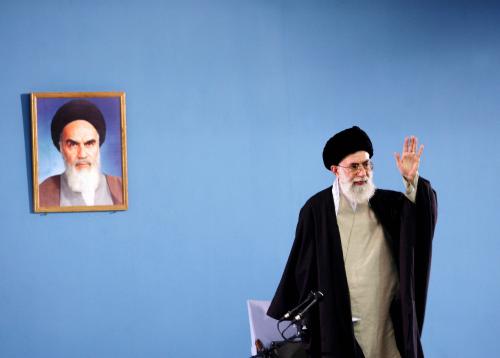
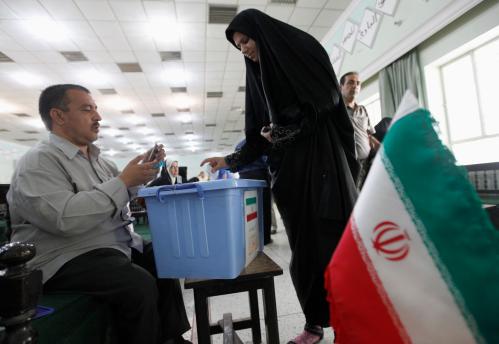
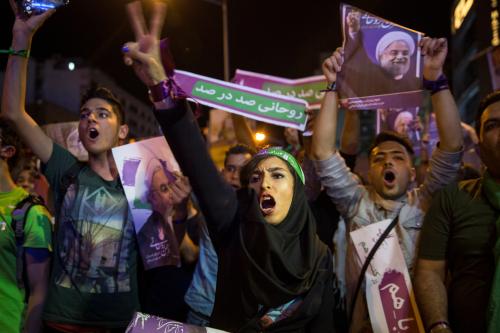

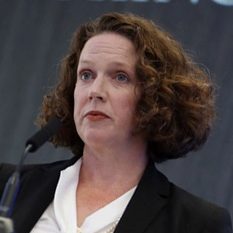

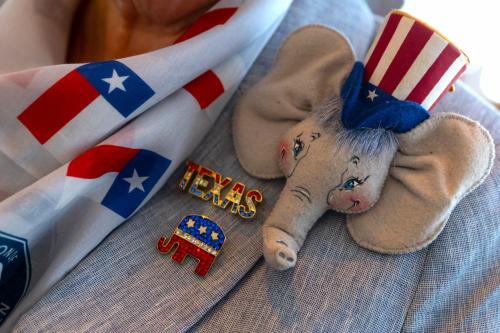
Commentary
He’s back! Ahmadinejad (re)enters the electoral fray
April 12, 2017